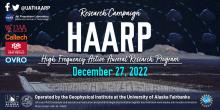Participate in HAARP Experiment Studying Near Earth Asteroids
Participate in HAARP Experiment Studying Near Earth Asteroids

The High-frequency Active Auroral Research Program (HAARP) will be conducting a research campaign on December 27, 2022, with transmissions between 1100-2300 UTC (0200-1400 AKST) on 9.6 MHz. Actual transmit times are highly variable based on real-time ionospheric conditions. All information is subject to change. Amateur radio operators are encouraged to listen for and record the echo of HAARP off of the asteroid and submit demodulated recordings in .wav or .mp3 format. See official HAARP press release for more information.
This campaign will be in support of a NASA Jet Propulsion Laboratory project, in collaboration with Caltech’s Owens Valley Radio Observatory Long Wavelength Array (OVRO-LWA) and the University of New Mexico Long Wavelength Array (UNM-LWA), testing the potential use of HAARP/OVRO-LWA/UNM-LWA for interior sensing of near-Earth asteroids (NEAs). This experiment will reflect HAARP transmissions off of NEA 2010 XC15, and the echo will be received by OVRO-LWA and UNM-LWA. The target asteroid will be roughly two lunar distances away from Earth at the time of transmission.
Characterizing the interior structure and composition of NEAs is critical for advancing our understanding of solar system evolution and aiding in planetary defense. Multiple lines of evidence indicate that many, if not most, NEA interiors are rubble piles, with a subset that are monolithic solids, but definitive answers will influence the response to potentially hazardous objects. Approximately 80 known NEAs passed within one lunar distance in 2019. This will increase as new search observatories come online (e.g., the Large Synoptic Survey Telescope and NASA's NEO Surveillance Mission). In particular, the asteroid Apophis will pass Earth at 34,000 km (~5 Earth radii) in 2029 and presents one of the best opportunities for direct observations of an NEA. The proximity and frequency of NEA flybys creates opportunities to repeatedly probe and study the interiors of NEAs using ground-based radar systems and to fill a strategic knowledge gap in our understanding of these objects.
Amateur radio and radio astronomy enthusiasts are invited to listen to the transmissions/echoes and submit reception reports to the HAARP facility at uaf-gi-haarp@alaska.edu, or by mailing a report to the address at the end of this document.
For real-time ionospheric conditions in Gakona, please consult ionograms from the HAARP Diagnostic Suite: https://haarp.gi.alaska.edu/diagnostic-suite
To request a HAARP QSL card, send reception reports to:
HAARP
P.O. Box 271
Gakona, Alaska 99586
USA
